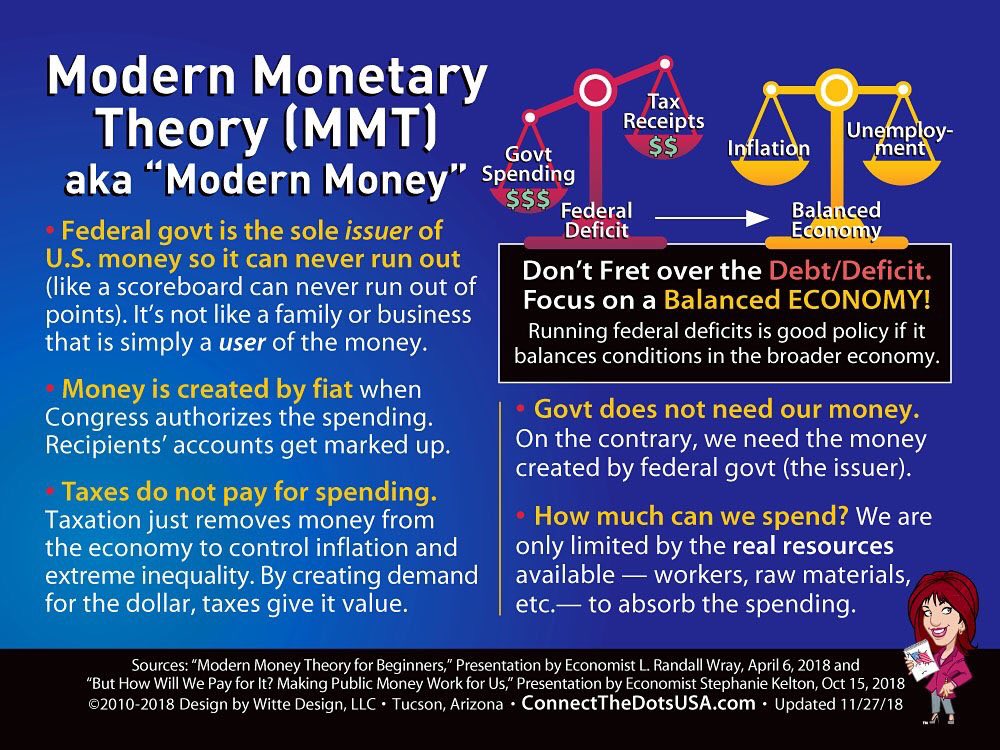Anyone concerned about climate change, the Green New Deal, or Degrowth is well advised to understand Modern Monetary Theory.
Richard Murphy is a Visiting Professor of Practice in International Political Economy, City University of London. He campaigns on issues of tax avoidance and tax evasion, as well as blogging at Tax Research UK
Cross-posted from Tax Research UK

What MMT says is as follows:
First, in a country with a fiat currency, which means that there is no asset backing (like gold) to the money in circulation, which means that the country’s money does as a result only get its value solely as a consequence of its government’s promise to pay, there is, at least in theory, no limit to the amount of money that a government can create. It’s important to note that every major currency in the world has been a fiat currency since 1971.
Second, a government creates money every time it spends because whenever it decides to do so it instructs its central bank to extend it the credit that makes this possible. It is not constrained by the availability of taxation funds when doing so: money can always be created by a bank on demand and at will, and central banks, like the Bank of England, will always do this when instructed to do so by the governments that own them.
Third, to prevent this new money creating excess inflation a government has to tax to withdraw currency from circulation. This is the primary fiscal purpose of taxation, although tax also has other, also significant, social purposes as well, as noted below. To be clear, when interest rates cannot be used to control inflation, as is the case in almost every developed country now (and many others as well) because official interest rates are at, or near zero, tax is the only tool available for this task. MMT is the only current school of economic thought that properly recognises this fact.
Fourth, the government does not need to borrow if it runs a deficit. Firstly that is because it can, as has now been agreed by the UK government and the Bank of England, simply run an overdraft at its central bank on which no interest may be charged. This negates the need for borrowing, whilst, second, government borrowing actually makes little economic sense in an economy using the fiat money of the national government because the money that is supposedly borrowed by the government has already been created by the very same government when injecting cash into the economy through its spending. The term borrowing is, then, a misnomer in that case. What instead a government does by supposedly borrowing is to provide a social and economic service as the depositor of last resort for the savings of its population and financial system, offering a form of security for funds that no one else can. That is the real function of government borrowing, and that savings facility is vital to the efficient operation of any fiat currency using economy.
Fifth, a government that recognises the significance of MMT is not indifferent to the way in which tax is levied, or to the non-payment of tax, even if sufficient tax is collected to secure the fiscal balance that it desires to control inflation. Tax might have that primary goal of controlling inflation, with the secondary advantage that the tax charged for this reason provides the currency with value, but tax also has the other deeply significant social purposes of correcting income and wealth inequality; repricing market failure; delivering fiscal policy by incentivising or penalising certain activities and by reinforcing the social contract that exists between a government and its electorate. Tax is a reflection of the values of the society we live in and is the primary mechanism any government has for reinforcing them. MMT cannot then be indifferent to tax and to claim that it might be is, therefore, completely incorrect. To be so would also mean that MMT was indifferent to the distributional impact of taxation, both nationally and internationally, and that is clearly not its intention.
Sixth, the fact that the government spends first, and taxes second, means that the answer to the question ‘how are you going to pay for it?’ is always available to anybody who understands this process. A government decision can always be paid for, presuming the actual resources required to deliver it exist within the economy, simply by commanding the central bank to pay for it and then arranging, if necessary, for the additional tax due on the income that has been generated (because all government expenditure is, by definition, somebody else’s income) to be collected.
Seventh, the realisation that a government that only borrows in its own currency cannot, as a result of this understanding, ever default on its own debt because it can always issue the instruction to its central bank that the payment of that debt be settled, is also of considerable advantage. Such a government should never be beholden to financial markets because they cannot hold a government that has the power to ignore them to ransom.
And that’s it. That is modern monetary theory in a nutshell. In essence, government can and does create money. Government debt is just a means for saving private wealth. If you want government created money (and you do) the government has to run a deficit. There is nothing to worry about in this policy so as long as the economy is not overheated as a result. And the art is in not over-heating. Tax can stop that over-heating. And the risk of over-heating is, anyway, much smaller than the risk from putting the economy in the fridge to avoid the chance of it doing so.
Some other things do, however, need to be made clear.
The first is that modern monetary theory does not fully apply, and cannot be as a result usually be used in the way described, when a government does not have a fiat currency, or has to borrow in the currency of another country, or lets the currency of another country be used in common circulation within its economy; then the preconditions for modern monetary theory to work do not necessarily exist. There is no point pretending that they do when they do not. A failing tax system also prevents MMT functioning in practice because the means to control inflation does not exist.
Second, modern monetary theory does not eliminate exchange rate risk. It still exists. That is in large part because most exchange rate risk has nothing whatsoever to do with government economic action. It is created by political risk, as has been the case with the substantial down-rating of sterling since the Brexit referendum took place; or it is created by external price shocks, as for example are commonplace with regard to energy and other raw material prices; or it can arise because of short-term speculation, which is only sustainable if economic fundamentals of the type previously noted have changed. But if a government that thinks it believes in modern monetary theory then believes as a consequence that it can create money without limit, then it is fundamentally wrong. Likewise, if it thinks it can spend without taking into consideration the limit of available resources within the economy itself and ignores entirely the impact upon imports then this too is wrong as such a policy will have a downward impact upon the balance of payments and the long-term value of the currency. That is precisely why MMT does not prescribe spending without limit or money creation without limit: it has never done any such thing. It does instead pay a lot of attention to the control of inflation. That said, it also suggests that all exchange rates should float, because that manages the exchange risks that no government can control with monetary or fiscal policy.
Third, there is absolutely no necessary relationship between modern monetary theory and a jobs guarantee, or any other left of centre economic policy come to that. MMT describes how the economy works. But if it is assumed that the object of managing the economy is the creation of full employment then these issues are related in the sense that it is obvious that modern monetary theory does permit the government to pursue a policy of full employment at fair wages if that is its wish. In that sense the job guarantee and MMT are intimately related, and are logical partners in the process of managing the economy to fulfil the needs of society, but this does not, of course, prevent there being the provision of other aspects to a social safety net. Nor does this link prevent a government that does not want to deliver full employment using the ideas implicit in MMT; it will just simply need to be held to account for why it would wish to choose unemployment as a policy option rather than full employment.
In summary, MMT is the best currently available description of how to manage an economy to deliver full employment. That is its merit.



Be the first to comment